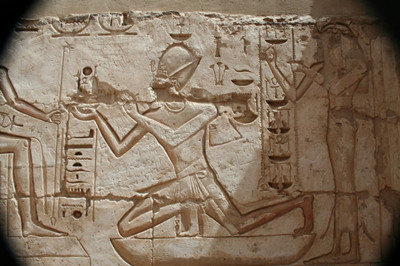The nearest modern equivalent I can think of to this is the ID card that everybody working in an office now has to wear round their necks to get past the security check. It's not immediately clear who was meant to read these labels, whether they're aimed at the gods of the afterlife or perhaps the servants that might not know their way around.
我認為這物品最相當于現(xiàn)代社會的辦公室里,大家都佩戴在脖子上通過安全檢查時的工作身份牌。我們現(xiàn)在不能立刻知道究竟這標簽是給誰看的,也許是來世中的神靈,也許是那些不認識自己國王的仆人們吧。
The images themselves are made by scratching into the ivory and then rubbing a black resin into the incisions, so that you get a wonderful contrast between the black and the cream of the ivory. So, through this little ivory name tag, we're immediately close to these first kings of Egypt; rulers around 3000 BC, of a new kind of civilisation that would produce some of the greatest monumental art and architecture ever.
這些圖像是先在這牙片上雕刻出來,然后再浸漬在黑色樹脂里,使樹脂滲進牙片的下凹處,于是就產(chǎn)生了美觀而對比強烈的黑白圖案。所以通過這小小的牙牌名片,我們馬上與那些埃及早期的法老王們接近了距離,他們是公元前3000年左右一種新文明的統(tǒng)治者,那文明產(chǎn)生了人類史上一些最偉大的不朽藝術(shù)與建筑。
Before the first pharaohs, Egypt was very much a country divided, split between the east-west Mediterranean-facing strip of the Delta in the north, and the north-south string of settlements along the river itself. With the Nile flooding every year, harvests were plentiful, so there was enough food for a rapidly growing population and there was still some surplus to trade with. But there was absolutely no extra fertile land beyond the flooding area.
然而在早期法老王出現(xiàn)之前,埃及還是一個四分五裂的國家,分割成位于北方三角洲、面向地中海的東部西部地帶,及沿著尼羅河的南北一長串的各個定居村落。隨著尼羅河年年一漲一息的洪水,農(nóng)作物年年豐收,所以支撐了人口的持續(xù)增加,同時還有一些盈余可以進行貿(mào)易。
So, inevitably, people fought over what land was available. Conflict followed conflict, with those from the Delta eventually being conquered by the people from the south and, just before 3000 BC, Egypt was united.
然而在尼羅河每年洪水淹沒不到的地方,卻絕對沒有肥沃的土壤,于是,不可避免的,人民開始爭奪那片最有利用價值的土地。年復(fù)一年,連綿不斷的沖突,最終三角洲一帶的部落被業(yè)自南方的人所征服了,于是古埃及大概于公元前3000年左右統(tǒng)一起來。












